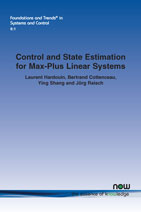Control and State Estimation for Max-Plus Linear Systems
Laurent Hardouin, Université d’Angers, France, laurent.hardouin@univ-angers.fr , Bertrand Cottenceau, Université d’Angers, France, bertrand.cottenceau@univ-angers.fr , Ying Shang, University of Evansville, USA, ys46@evansville.edu , Jörg Raisch, Technische Universität Berlin, Germany, raisch@control.tu-berlin.deAbstract
Max-plus linear systems theory was inspired by and originated from classical linear systems theory more than three decades ago, with the purpose of dealing with nonlinear synchronization and delay phenomena in timed discrete event systems in a linear manner. Timed discrete event systems are driven by discrete events, are equipped with a notion of time, and their temporal evolution is entirely characterized by the occurrence of events over time. If their behavior is completely governed by synchronization and delay phenomena, timed discrete event systems can be modeled as max-plus linear systems. On appropriate levels of abstraction, such systems adequately describe many problems in diverse areas such as manufacturing, communication, or transportation networks. The aim of this paper is to provide a thorough survey of current research work in max-plus linear systems. It summarizes the main mathematical concepts required for a theory of max-plus linear systems, including idempotent semirings, residuation theory, fixed point equations in the max-plus algebra, formal power series, and timed-event graphs. The paper reviews some recent major achievements in control and state estimation of max-plus linear systems. These include max-plus observer design, max-plus model matching by output or state feedback and observer-based control synthesis. Control is required to be optimal with respect to the so-called just-in-time criterion, which is a common standard in industrial engineering. It implies that the time for all input events is delayed as much as possible while guaranteeing that all output events occur, at the latest, at pre-specified reference times.
Control and State Estimation for Max-Plus Linear Systems
Max-plus linear systems theory was inspired by and originated from classical linear systems theory more than three decades ago, with the purpose of dealing with nonlinear synchronization and delay phenomena in timed discrete event systems in a linear manner. Timed discrete event systems describe many problems in diverse areas such as manufacturing, communication, or transportation networks.
This monograph provides a thorough survey of current research work in max-plus linear systems. It summarizes the main mathematical concepts required for a theory of max-plus linear systems, including idempotent semirings, residuation theory, fixed point equations in the max-plus algebra, formal power series, and timed-event graphs.
The authors also review some recent major achievements in control and state estimation of max-plus linear systems. These include max-plus observer design, max-plus model matching by output or state feedback and observer-based control synthesis.
Control and State Estimation for Max-Plus Linear Systems offers students, practitioners, and researchers an accessible and comprehensive overview of the most important recent work in max-plus Linear Systems.
